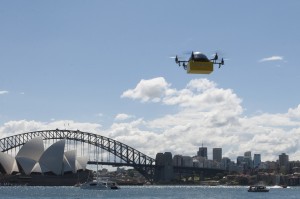
At the risk of droning on, it seems like there has been a lot of news involving drones lately. We covered Amazon’s announcement of package delivery (someday) via drones, and some responses to it. Clearly, drone services could fill the middle range between snail-mail delivery and electronic downloading: a physical good that reaches you quickly. And that is not even considering the other potential uses, such as aerial photography.
But that is in the nebulous future. What about now?
Well, the problem with drone use right now is that commercial drone use is technically illegal—the FAA hasn’t yet come up with rules to regulate it. This means that entrepreneurs who try to use it, such as this florist who wanted to deliver flowers by drone, are not permitted without exceptions the FAA can only make on a case-by-case basis.
Not that this is stopping them, however. Commercial drone users who keep a low profile can get away with quite a lot, including filming sports team training, weddings, and even a scene from The Wolf of Wall Street. The FAA isn’t really very well-equipped to detect and shut down unauthorized drone use that isn’t advertised.
The problem is, sometimes drone accidents can lead to safety issues. Sometimes these accidents can be rather humorous, but others have the potential to be more serious. One man was actually killed by his own model helicopter—not actually a drone, but similar in principle. The bigger the drone, the more damage it can do falling out of the sky.
But the opposite problem is that government’s slowness to regulate could be harming innovation. Gizmodo reports on an initiative in Dubai to use retina-scanner-equipped drones for delivering confidential government documents that is possible because Dubai doesn’t have the sort of bureaucracy inherent in the FAA to get in the way. And Australia was planning a drone textbook delivery service even before Amazon.
Don’t expect regulations any time soon. A 2010 law set a September 2015 deadline for the FAA to allow commercial drone use, but the Transportation Department’s inspector general was not optimistic it would meet the deadline. Until those regulations are in place, none of these American drone delivery services can move forward.
That being said, some businesses are clearly not letting grass grow beneath their feet in setting up their own drone initiatives. Just look at what Netflix is planning, for example. (Found via The Digital Reader.)































I wonder about the increased use by humans of the airspace between the surface of the arth and up to where planes fly and our effect on inscets and birds. It is one thing to worry abt drones crashing into people, each other, whatever, but when drones use space birds and insects use I can’t imagine drone developers or users will have concern, or the abilty to avoid birds or insects.
For instance, I can imagine drones doing a lot of flying at night through areas used in the Spring and Fall when some birds migrate. Not to mention bats at night. I realize bats use a sort of echolocation, but won’t drones at night be disruptive to bats as well?